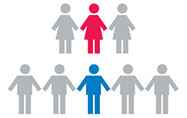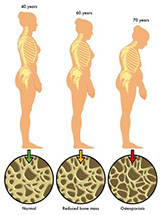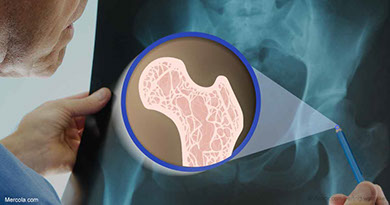WHAT IS OSTEOPOROSIS?
Osteoporosis is bone disease. It is most common in women and men over the age of 50 years. Bones become porous and brittle, they easily brake. People with osteoporosis have lost too much calcium from the bones. Calcium is a mineral that provides bones with firmness and flexibility. The skeleton contains 99% of the total body weight of calcium.  Thus, the basic calcium reserve in the body is in the bone. It all starts here. Due to insufficient calcium intake, that is, due to inadequate nutrition, mucous membrane disorders or altered hormonal status, there is a lack of calcium. There are problems here. Calcium deficiency is compensated by large stocks in bones in order to provide the necessary functions of the organism. The reimbursement process often takes years without any visible symptoms. Throughout this time, the dynamic balance of deposit and release of calcium has been disrupted, and demineralization causes softening and bubbling of bone tissue, that is, osteomalacia and osteoporosis. Osteoporosis is accompanied by difficult mobility, bone and joint pain, cramps and weakness in the muscles, reduced height, increased risk of bone fractures, and spontaneous fractures. However, osteoporosis is often diagnosed only when the disease progresses and when the bone mass is so reduced that even a sudden movement or seemingly harmless fall can cause a bone fracture.
Thus, the basic calcium reserve in the body is in the bone. It all starts here. Due to insufficient calcium intake, that is, due to inadequate nutrition, mucous membrane disorders or altered hormonal status, there is a lack of calcium. There are problems here. Calcium deficiency is compensated by large stocks in bones in order to provide the necessary functions of the organism. The reimbursement process often takes years without any visible symptoms. Throughout this time, the dynamic balance of deposit and release of calcium has been disrupted, and demineralization causes softening and bubbling of bone tissue, that is, osteomalacia and osteoporosis. Osteoporosis is accompanied by difficult mobility, bone and joint pain, cramps and weakness in the muscles, reduced height, increased risk of bone fractures, and spontaneous fractures. However, osteoporosis is often diagnosed only when the disease progresses and when the bone mass is so reduced that even a sudden movement or seemingly harmless fall can cause a bone fracture.
WHO IS AT RISK?
Primarily, women are at risk in menopause and even more in postmenopausal women who have previously lost menstrual cycles  (before 45 years of age), either because of the surgical removal of the ovaries and the uterus or spontaneously. Women who have had periods without menstruation, as well as those who have received the first period of menstruation (menarche). In women older than 50 years, the risk of osteoporotic fractures is as great as the risk of cardiovascular disease, and four to six times that of the risk of breast cancer. It is believed that sex hormones, specifically estrogen in women, and testosterone in men, have a protective role for the bones. Reduction, and especially the loss of these hormones after menopause, leads to a progressive loss of bone mass, which is even 2-4% per year in women 5-10 years after menopause
(before 45 years of age), either because of the surgical removal of the ovaries and the uterus or spontaneously. Women who have had periods without menstruation, as well as those who have received the first period of menstruation (menarche). In women older than 50 years, the risk of osteoporotic fractures is as great as the risk of cardiovascular disease, and four to six times that of the risk of breast cancer. It is believed that sex hormones, specifically estrogen in women, and testosterone in men, have a protective role for the bones. Reduction, and especially the loss of these hormones after menopause, leads to a progressive loss of bone mass, which is even 2-4% per year in women 5-10 years after menopause
HOW TO REDUCE RISK FACTORS?
In most cases osteoporosis can be prevented. It can also be treated in many people. There are some ways to change your lifestyle, which will help you prevent the onset of osteoporosis. Adults over 50 years of age need 1500 mg of calcium each day to conserve bone mass and reduce the risk of fracture. In order to enter this amount of calcium, it is necessary to:
- Take balanced meals
- Eat foods rich in calcium such as dairy products (primarily cheese and yogurt). Two cups of milk will provide 600 mg of calcium plus vitamin D, which helps your body absorb calcium.
- Limit the intake of alcohol and caffeine
- Stop smoking (and stay in the smoking rooms)
- be active: fast, sharp stroke, light aerobics and dancing, helping you to hold firm bones.
What are the consequences of osteoporosis?
 Bone fractures are the most common problems caused by osteoporosis. The fracture of the hip, spinal vertebrae and wrist is most common. The worst fractures of the hip, since they can lead to permanent disabling, long-term hospital treatment and loss of autonomy. In early stages it does not show any symptoms, but leads to brittleness and weakening of the bones to the point when it is very easily broken - especially on the wrists and hips . In more serious cases, it can lead to bending or even breaking the spine. A well-designed exercise program can already do much to help prevent this serious loss of bone density and start from the initial position in the race with osteoporosis. It is necessary to begin already in these years, because if you leave for later, you will not be able to get used to the demands that physical exercises imply, so it is likely that you will very quickly give up on any program you start with.
Bone fractures are the most common problems caused by osteoporosis. The fracture of the hip, spinal vertebrae and wrist is most common. The worst fractures of the hip, since they can lead to permanent disabling, long-term hospital treatment and loss of autonomy. In early stages it does not show any symptoms, but leads to brittleness and weakening of the bones to the point when it is very easily broken - especially on the wrists and hips . In more serious cases, it can lead to bending or even breaking the spine. A well-designed exercise program can already do much to help prevent this serious loss of bone density and start from the initial position in the race with osteoporosis. It is necessary to begin already in these years, because if you leave for later, you will not be able to get used to the demands that physical exercises imply, so it is likely that you will very quickly give up on any program you start with.
How to diagnose osteoporosis??
It is possible to prevent osteoporosis, slow down her continuation, and heal the already occured osteoporosis. Of course, the  sooner it is done the degree of bone density and determine the risk of developing osteoporosis, these are more opportunities for prevention and / or treatment. The mass and bone density with which a woman enters the menopause and the progression of bone loss after menopause are two of the most important factors in determining probabilities for the development of osteoporosis. Now we can measure the bone density in the menopause by BMD testing (osteodensitometry). In addition, other tests are available, called biochemical markers or bone markers. They identify people who quickly lose their bone. Osteodensitometry and biochemical marker tests can detect women in menopause with a high risk of osteoporosis, which allows the start of preventive treatment before too much bone is lost.
sooner it is done the degree of bone density and determine the risk of developing osteoporosis, these are more opportunities for prevention and / or treatment. The mass and bone density with which a woman enters the menopause and the progression of bone loss after menopause are two of the most important factors in determining probabilities for the development of osteoporosis. Now we can measure the bone density in the menopause by BMD testing (osteodensitometry). In addition, other tests are available, called biochemical markers or bone markers. They identify people who quickly lose their bone. Osteodensitometry and biochemical marker tests can detect women in menopause with a high risk of osteoporosis, which allows the start of preventive treatment before too much bone is lost.
Contact
Narcissus d.o.o.
Serbia, Ada, Molski Put 3.
024/852-611
024/853-396
narcis.ada@gmail.com
Copyright © 2018 Narcissus
